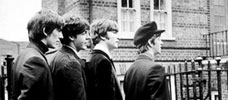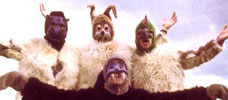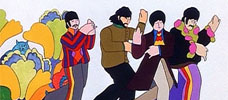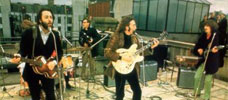Reviews
Richard Lester
UK, 1965
Credits
Review by Megan Weireter
Posted on 06 September 2009
Source Apple DVD
Categories The Beatles on Film
If A Hard Day’s Night takes a realistic approach to exploring themes of escape, Help! is itself sheer escapism. Nominally a chase movie, it’s less of a coherent statement than a series of episodes of increasing silliness, though, it must be said, it is an engaging and frequently quite clever silliness that more than holds your attention. Even if it seems forever destined to suffer by comparison to A Hard Day’s Night — indeed, even in this review you’ll see that I’m totally guilty of making the comparison — Help! is heaps of fun, capturing the Beatles at the very pinnacle of their commercial success as they laugh their way through a madcap farce.
On the heels of the runaway success of their first film, there seemed little to do but start in on the next one. The Beatles had made a three-film deal with United Artists, so to some extent Help! was born of contractual obligations (and, occasionally, feels that way). But of course, since the release of A Hard Day’s Night the Beatles had hardly faded into obscurity, as had once been feared — indeed, they had remained as huge as ever, a phenomenon that now looked poised to stick around for a long, long while. So Dick Lester came back on board to direct their second film, this time with a much larger budget that allowed for stunts, pyrotechnics, more music, and most of all, color. In fact, the marketing campaign for Help! made quite a big deal about being able to see your idols in color in their newest film. So, in a fairly witty move, the first shot we see of the Beatles is in a small film-within-a-film, and it’s in black and white. Brightly colored darts, thrown at the screen by Clang (the villain), fly onto their faces as they sing and play the title song. It’s a nice visual joke in a film that’s stuffed with them.
The plot, such as it is, revolves around Ringo wearing a ring that is sacred to the adherents of a bizarre, human-sacrifice-obsessed sect of Hinduism. (It was sent to him in a fan letter, we eventually learn.) Their religion dictates that they must have the ring in order to continue to make human sacrifices — or else they must sacrifice Ringo. The problem is that the ring seems stuck fast onto his finger. And so powerhouse actor Leo McKern (who’s sadly wasted here, and upstaged constantly) and Footlights alumna Eleanor Bron (who comes off better), breaking out their hammiest Indian accents, come to Britain from India and chase the Beatles all over the country and the world to get the ring back. Somewhere along the way, a couple of scientists convinced that the ring would give them the power to — dare I say it? — rule the world join in the chase as well. It’s basically a framework on which to hang all sorts of zaniness, including side trips to the Bahamas and to Austria that the Beatles specifically requested.
It also brings in some flavor from the recent spate of James Bond films, which ever since 1962’s popular Dr. No had taken the British filmmaking world, to say nothing of the rest of the world, by storm. The elements of Bond parody don’t dominate Help! too heavily, but they’re there: the over-the-top costumes worn by Eleanor Bron, a glamorous double agent and Bond-girl stand-in, for instance, and Ken Thorne’s scoring of Beatles songs (“A Hard Day’s Night” and “I’m Happy Just to Dance with You” are only the most obvious ones) into gigantic brass-heavy orchestral settings that mimic Bond movie soundtracks. And then there are Foot and Algernon, the scientists, whose elaborate gadgetry and weaponry always fails or blows fuses, because, as they sigh to each other, it’s all British, and everyone knows British gadgets never work.
This note of parody is only one note that makes Help! feel quite a bit more dated than its predecessor, but at the time Help! seems to have helped influence a small crop of cutting-edge surreal comedies that came after, such as the Monkees’ Head and the later Peter Sellers vehicles How I Won the War and The Magic Christian (which costarred John Lennon and Ringo Starr, respectively). Whereas A Hard Day’s Night feels quite singular (its elements might be parodied or quoted, but its essence is never wholly captured, despite lots of contemporary rock bands’ attempts to rip it off), Help! feels very much like a product of its time. It could only have been made in the ’60s. But unfortunately, it could have been made with virtually any band.
When John Lennon later described the experience of filming Help! as feeling like “extras in our own movie,” this is what he was talking about. By imposing this plot onto heavily and obviously fictionalized Beatle personas, Help! ends up virtually ignoring the Beatles’ mythos, the thing that theoretically makes them special in the first place. In A Hard Day’s Night a great effort was made to develop and spend some time with each Beatle personality, but Help! gets too mired in plot for us to see much of that. As passive recipients of a plot that basically happens to them, the Beatles get little chance to show off their own unique talents outside of the musical numbers. While this doesn’t necessarily have to be viewed as a weakness, it does make film feel a bit off, a bit scattered, as if it’s forgotten its purpose.
In addition to the plot, the film gets mired in its own wit. Lester packs Help! with fantastic visual gags, the best of which is probably the early scene in which the Beatles walk into separate middle-class English terrace houses that, we soon realize, are actually just separate doors into a crazy bohemian pad. John’s pit-for-a-bed, George’s lawn-for-a-carpet (complete with hired grass cutter/flautist), and Paul rising up from the floor playing a white pipe organ are all some of the most memorable visuals in the whole film. Also clever are the details of “Paul’s adventure on the floor,” complete with Wrigley’s gum wrapper for modesty. And then there’s Lester’s play with title cards — we get a brief Intermission — and with other onscreen visual tricks, like the musical notes in the “Ticket to Ride” sequence. (More on the musical scenes in a moment.) To complement this vision, screenwriter Charles Wood delivered a script dense with hilarious, sarcastic wordplay that flies fast and furious, in a breakneck style that, again, unambiguously places this film square in the �60s. Not a single chance for a funny line, or a funny moment, isn’t exploited, and it makes for a breathlessness that becomes almost exhausting. It works for the Beatles, who were famous wits anyway, but it also contributes to the artificiality that underlines everything here — the one-liners are breezily funny, and they could have been delivered by almost any actor as well as (or better than) the Beatles. Which might explain why the Beatles, who weren’t actors, seem to have enjoyed the experience of making Help! less than A Hard Day’s Night.1
The Beatle who does stand out in Help! is Ringo Starr, who might not have been an actor yet, but would go on to become a bit of one. Already recognized for his breakout work in his long solo scenes in A Hard Day’s Night, Starr’s ability to actually act, and his particular skill at portraying a hangdog comic foil, shine here. The roles the band play onstage are turned on their heads in the film — the rest of the band is backing up Ringo, whose every sad-eyed face and deadpan line delivery is brilliant. The genuine astonishment he conveys in lines like “Well, I thought she was a sandwich!” (Help!, like its predecessor, is incredibly quotable), and the wistfulness as he describes how he used to like to keep his head between railings when he wasn’t using it for school, showcase a real comic talent.
But even if Ringo is the only actor who stands out, musically the Beatles are better than ever. Once again, the Beatles delivered seven soundtrack songs that showed off their increasing musical maturity, including an original song by George Harrison (“I Need You,” only his second composing credit). But John Lennon’s songs are the most compelling on the Help! soundtrack — the title song is his, as are “You’ve Got to Hide Your Love Away” and “Ticket to Ride,” and all three might be some of the finest songs he ever wrote. They are so mature, in fact, that unfortunately Paul’s and George’s contributions seem inevitably thinner, which makes the soundtrack, though quite good, ultimately feel more uneven than that of A Hard Day’s Night.
Also interesting about A Hard Day’s Night is that the musical sequences tend to dominate the film — which makes sense, since it’s a film about a rock band. Help!, though, is not a film about a rock band, really, as the Beatles’ musical career is never exactly crucial to the plot. So the musical sequences feel a little more shoehorned in, particularly the ones that take place on Salisbury Plain, for “I Need You” and “The Night Before.” The scenes are well shot, but the band is clearly only playing there so that we can be led into the various explosions and tank-fighting on the Plain that are to come after. Two of the musical scenes, though, are fantastic — the “Ticket to Ride” sequence, and the “Another Girl” sequence. Both of them are stronger than anything in A Hard Day’s Night, even the famous “Can’t Buy Me Love” scene in the field.
“Ticket to Ride” is frequently lauded as one of the great early music videos, and does indeed stand on its own. Though it’s only speculation, it’s possible that Lester went out of his way to make this one interesting, since “Ticket to Ride” was the only song on the soundtrack that would have been heard before by the target audience — it had been released as a single that spring. At any rate, this was filmed in the Austrian Alps, where Lester put the Beatles in skis — none of them had ever skied before — and just filmed them learning how to do it, complete with lots of falling down. These scenes are interspersed with them playing a piano in the snow and various other surreal touches, and though it may not sound like much, it all makes for a beautiful video somehow. I feel like I haven’t read enough in praise of the “Another Girl” video, though, which is also quite strong. Now the Beatles are in the Bahamas, and Lester plays around with different filters in the gorgeous Caribbean sunlight as they merrily play their guitars on the rocks. There begins to be some confusion as to who plays what instruments, which leads to some funny scenes in which George struggles with Paul’s left-handed bass and Ringo looks befuddled as he strums an acoustic guitar. By the end, Paul’s guitar has actually turned into a blank-faced girl in bikini, whom he’s maneuvering in order to play her like a guitar. It’s a little creepy and sexist, but it’s also a pretty clever comment on their rock star lifestyle at this point, seeing as how girls in the audience would all probably kill to be Paul’s guitar.
And ultimately, all that Help! needed to do was to find its way to those girls, who would have come to the movie theatre to see the Beatles in pretty much any film at all. And if it’s generally agreed that Help! isn’t the surprising work of excellence that A Hard Day’s Night was — even if it’s generally agreed to be, in some ways, a giant mess — there’s still plenty of Beatles eye candy to go around, plus a ton of laughs. And if Help! hasn’t aged as well as the Beatles’ music, that can hardly be that surprising either. In a way, it’s a shame that the Lester and the Beatles so outdid themselves on their first film collaboration, for their second and final collaboration is hardly anything to be ashamed of. It’s a riot.
More The Beatles on Film
We don’t do comments anymore, but you may contact us here or find us on Twitter or Facebook.








